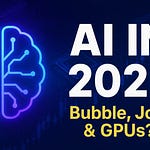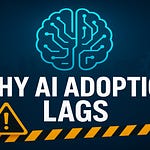🥈Heavy Silver
My novel HEAVY SILVER is out! You can read more about it and watch BOTH trailers here:
https://www.heavysilver.net/
🧭 New Era Pathfinders
Check out my growth community for navigating the Fourth Industrial Revolution! The New Era Pathfinders is a group of people looking to find meaning and build a career in the next wave. I am now teaching FOUR frameworks for adaptation!
https://www.skool.com/newerapathfinders/about
TLC - Therapeutic Lifestyle Changes for a balanced, happy, and healthy lifestyle.
PBL - Project Based Learning to master any skill or technology
Systems Thinking - To approach problems like I do, and other geniuses like Mark Zuckerberg and Elon Musk
RUPA - My proprietary framework specifically for pivoting into the 4IR and Meaning Economy. It means “Reduce worry, Understand impact, Prepare for changes, Adapt and align”
🧠 Complex Adaptive Systems: The Key to AI Safety and Regulation
Complex adaptive systems (CAS) provide the most effective framework for understanding artificial intelligence safety and regulation. The stock market and social media serve as familiar examples of complex adaptive systems. These systems exhibit key characteristics that are crucial for comprehending AI behavior and risks.
📊 Characteristics of Complex Adaptive Systems
Complex adaptive systems demonstrate emergence, where complex behaviors arise from simpler rules. Self-organization occurs spontaneously without external control. Non-linearity leads to unpredictable outcomes, similar to viral effects in media. Feedback loops, both positive and negative, influence system behavior. Adaptation allows the system to modify its behavior in response to environmental changes. Coevolution involves different components of the system evolving in relation to each other. The edge of chaos represents the balance between order and disorder where systems are most adaptable. Attractor states are conditions towards which systems tend to evolve.
🧩 Emergence: Complex behaviors arise from simpler, lower-level rules.
🔄 Self-organization: Spontaneous creation of order and structure without external control.
📈 Non-linearity: Relationships between components are not proportional, leading to unpredictable outcomes.
🔁 Feedback loops: Both positive (virtuous cycles) and negative (vicious cycles) feedback mechanisms exist within the system.
🔄 Adaptation: The system modifies its behavior in response to changing environmental conditions.
🌱 Coevolution: Different components of the system evolve in relation to each other over time.
🔀 Diversity: Multiple types of agents or components interact within the system.
🌪️ Edge of chaos: The system operates at a balance point between order and disorder, where it is most adaptable and creative.
🎯 Attractor states: Conditions or patterns towards which the system tends to evolve, regardless of starting points.
These characteristics collectively define the complex, dynamic nature of CAS and help explain their behavior across various domains, from biological ecosystems to social networks and artificial intelligence systems.
🌐 Social Media as a Complex Adaptive System
Social media platforms exemplify complex adaptive systems. They involve millions of users interacting through posts, likes, and other engagements. Platforms themselves act as stakeholders with their own rules and systems. Emergent trends like viral content and collective behaviors arise. Epistemic tribes form around shared beliefs. Nonlinear effects manifest when single posts lead to significant consequences like cancellations or viral spread of ideas.
💻 Cybersecurity in Complex Adaptive Systems
Cybersecurity incidents demonstrate the interconnected nature of complex adaptive systems. A forced antivirus update causing widespread system failures illustrates how seemingly isolated events can have far-reaching consequences. Cloud infrastructure relies on various operating systems, and disruptions to one component can lead to cascade failures affecting numerous services and businesses.
🤖 Applying Complex Adaptive Systems to AI
Artificial intelligence will not manifest as a single, monolithic entity. Instead, billions of AI agents will participate in complex environments with diverse incentive structures. This distributed nature challenges the notion of controlling a single superintelligence. AI agents will interact not only with humans but also with other systems and APIs, necessitating robust verification methods like zero trust principles.
🛡️ Strategies for AI Safety in Complex Systems
To manage risks in AI systems, several strategies derived from complex adaptive systems can be employed. Implementing choke points or gates can contain risk by requiring verification at key junctures. Creating smaller failure domains helps limit the impact of potential issues. Stop-gap measures, similar to circuit breakers in stock markets, can halt operations if unusual behavior is detected. Guardrails and boundaries can constrain AI actions, while monitoring resource access can identify potentially problematic behavior.
🛡️ Choke Points: Strategic points in the system where verification or control measures are implemented to manage risk and ensure proper functioning.
🛑 Stop-Gap Measures: Automatic safeguards that halt operations when unusual or potentially dangerous behavior is detected, similar to circuit breakers in stock markets.
🏗️ Smaller Failure Domains: Segmentation of the system into smaller, isolated components to limit the impact and spread of potential failures or issues.
🚧 Guardrails: Boundaries and constraints implemented to restrict actions within predefined safe parameters.
🔍 Resource Access Monitoring: Continuous surveillance of resource usage and access patterns to identify abnormal or unauthorized activities.
🔀 Diversification: Introducing variety in system components and processes to increase resilience and reduce systemic risks.
🔄 Adaptive Regulation: Flexible regulatory frameworks that can evolve alongside the system they govern, responding to new challenges and behaviors.
🤝 Consensus Mechanisms: Protocols requiring agreement from multiple system components before critical actions are taken, enhancing security and stability.
🔬 Transparency and Auditability: Ensuring system actions and decision-making processes are observable and can be reviewed for compliance and safety.
🧪 Simulation and Stress Testing: Regular evaluation of system behavior under various scenarios to identify vulnerabilities and improve robustness.
These principles form a foundation for managing and regulating complex adaptive systems, aiming to balance innovation and functionality with safety and stability across various domains, including artificial intelligence, financial markets, and cybersecurity.
🔍 Learning from Existing Complex Systems
Studying existing complex adaptive systems provides valuable insights for AI regulation and best practices. Economic safeguards, cybersecurity frameworks, and energy grid management offer lessons in managing cascade failures and implementing effective controls. By applying these principles to large-scale AI deployments, a more robust approach to safety and regulation can be developed.
🌐 Social Media
Characteristics: Millions of users interact through platforms, creating emergent trends and collective behaviors.
Epistemic tribes form around shared beliefs and information consumption patterns.
Nonlinear effects manifest when single posts lead to significant consequences like viral spread or cancellations.
Lessons: The power of network effects in information dissemination.
The importance of moderation and content filtering to manage system-wide impacts.
The need for mechanisms to counter misinformation and echo chambers.
📊 Stock Markets
Characteristics: Multiple stakeholders (investors, companies, regulators) interact, each with their own incentives.
Prices emerge from countless individual decisions and react to information in nonlinear ways.
Feedback loops create phenomena like bubbles and crashes.
Lessons: The effectiveness of circuit breakers in preventing extreme volatility.
The importance of transparency and information disclosure for system stability.
The need for diverse participants to maintain market efficiency.
💻 Cybersecurity and Cloud Infrastructure
Characteristics: Interconnected systems where small disruptions can lead to widespread cascade failures.
Constant adaptation between attackers and defenders creates an evolving threat landscape.
The system exhibits emergent behaviors that can be difficult to predict or control.
Lessons: The critical importance of redundancy and failover systems.
The value of zero-trust architectures in managing complex interactions.
The need for rapid response and adaptation to new threats.
🐝 Swarming and Hive Animals
Characteristics: Simple individual behaviors lead to complex collective outcomes.
Self-organization creates efficient structures and behaviors without centralized control.
The system adapts to environmental changes through collective decision-making.
Lessons: The power of simple, local rules in creating robust global behaviors.
The importance of individual diversity for system-wide adaptability.
The effectiveness of decentralized decision-making in complex environments.
These examples of Complex Adaptive Systems offer valuable insights for designing and managing AI systems. They demonstrate the importance of understanding emergent behaviors, implementing safeguards against unintended consequences, and creating flexible, adaptive regulatory frameworks. By learning from these diverse systems, we can better prepare for the challenges and opportunities presented by increasingly complex AI ecosystems.











